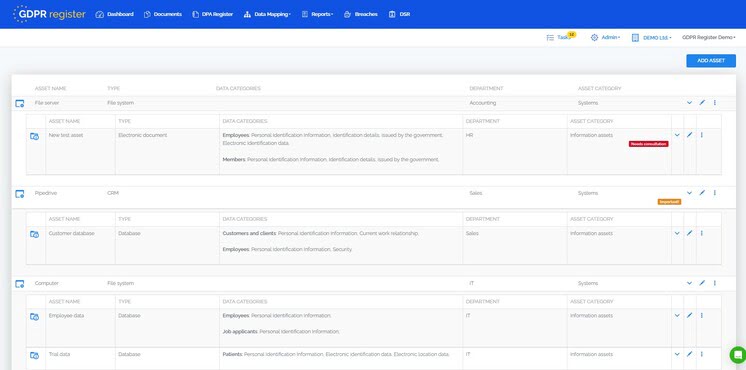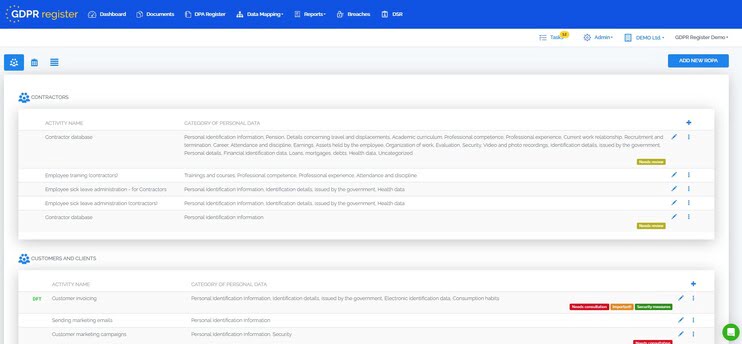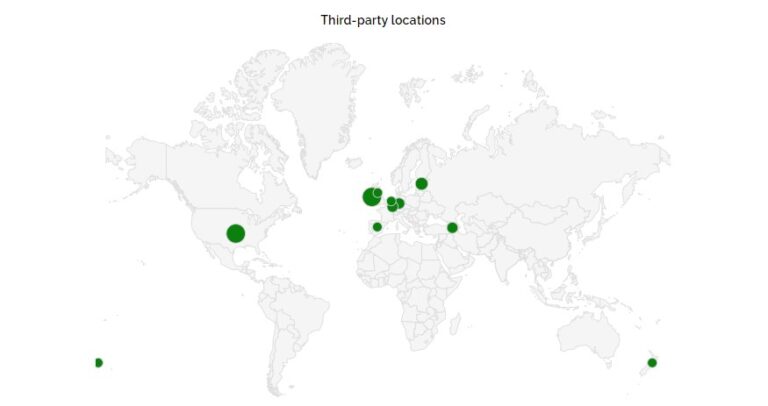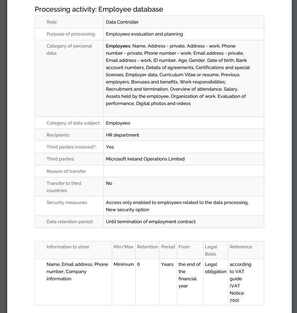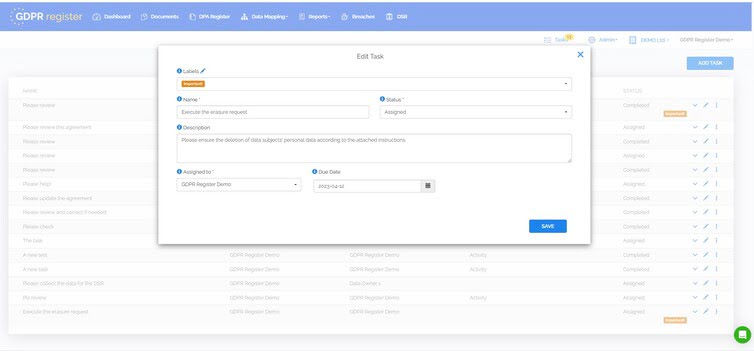GDPR Data Mapping for Teams
Achieve more clarity with less effort
With GDPR Register's Data Mapping tools, you will clearly understand where personal data is stored, where it originates from, how it's processed, and what parties are involved in the processing. Simple and effective for the whole privacy team.

Start fast with straightforward interface
Save time by using common activity templates
Engage your team and stakeholders
Monitor the progress of your project
Ensure correct result with solid data
Be ready for reporting at any moment
Features of Automated Data Mapping Tools
Asset Inventory
With Asset Inventory you can define in which systems you store personal data, which data subject category the data belongs to, where the data comes from, whether there are tried parties involved and who is the owner of the asset.
Assets can include each other (for example a physical server includes software and software includes a data set with information) or act as a source of information for other assets, third parties or processing activities.
Setting up correct asset inventory will ensure you have a thorough understanding of your data and it will simplify the creation of all other required documentation.
Your IT team will benefit from Asset Register, which they may require for their ISO27001 compliance. Working together, you will reach a solid understanding of data flows and security measures applied at each stage of personal data processing.
Records of Processing Activities (RoPAs)
GDPR Register is the easiest-to-use RoPA management software on the market. It allows you to create records from an extensive library of templates or from scratch feeding information from information assets.
If you already have spreadsheets with records, we will import them for you as a part of a service at no extra cost.
GDPR Register’s RoPAs support all the data required by GDPR, nFADP, POPIA and other regulations requiring records of processing activities, but is not limited to. You can create more custom fields of different types for the purpose and transparency of your organisation.
Vendor Management
You can link any element of the data mapping tool to another. This enables you to see at what stage of processing your vendors are in, if the data processing agreement is signed, what the security measures are and if an international data transfer is involved..
Store all your Data Processing Agreements in the GDPR Register or link to your existing contract life-cycle management tool. All information is accessible in one single place.
Reporting and Exporting
In just a few clicks, produce reports related to RoPAs, Data Processing Agreements, Data Retention Schedules and much more.
Apply filters to find proper records and filter the content inside them. Translate reports to more than 36 languages.
Flexible exporting tools will allow you to produce any external reports, export information to produce other documents and make backup copies for your security.
Team Collaboration
To reduce the workload of DPO and improve accuracy of information, it is advisable to involve stakeholders in the GDPR data mapping process. GDPR Register provides special permission levels for stakeholders allowing them to focus on their area of responsibility and simplifying the process. Coupled with task management and workflows, it provides perfect control over data mapping projects.
If you would like to concentrate on your work and be sure the mapping project is delivered right, our project management service will guarantee proper training of the team and smooth delivery of tasks.
Would like to see how it works?
After the demo session, we will provide you with a 14-day trial.
Frequently Asked Questions
What is the GDPR?
The General Data Protection Regulation (GDPR) is a pivotal data protection law in the EU, effective from May 25, 2018, aimed at enhancing individuals’ control over their personal data. It standardizes data protection across EU member states, imposing strict rules on data collection and handling, ensuring explicit consent for data processing, and granting rights like data access, correction, and erasure.
The GDPR mandates immediate notification of data breaches, requires organizations to demonstrate compliance, and imposes hefty fines for non-compliance, highlighting its emphasis on transparency, security, and upholding individual data rights.
What is data mapping, and why is it important?
Data mapping, in the context of GDPR (General Data Protection Regulation), refers to the process of identifying, documenting, and managing the flow of personal data within an organization.
This process is essential for understanding the ‘data flow‘ — the path through which personal data travels from collection to storage and processing. It involves pinpointing where personal data is stored, its source, how it is processed, and who is involved in the processing. Effective data mapping under GDPR must account for all aspects of personal data handling, including data transfer between different departments or external entities.
Is data mapping a legal requirement?
Yes, data mapping is effectively a legal requirement under the GDPR. While the regulation does not explicitly use the term “data mapping,” it mandates several obligations that necessitate this process. Key requirements include:
Article 30 Records: Organizations must maintain detailed records of processing activities, which is impossible to do accurately without a clear understanding of data flows.
Data Protection Impact Assessments (DPIAs): For certain types of processing, DPIAs are required, which again rely on the knowledge of how data is processed and flows within the organization.
Accountability Principle: GDPR introduces the principle of accountability, requiring organizations to demonstrate compliance with its provisions, including showing how they handle personal data.
Therefore, while not directly stated, a data map is a fundamental part of meeting GDPR’s requirements.
What are data subject access requests?
Data Subject Access Requests (DSARs) are a key provision under the GDPR, empowering individuals with the right to access their personal data held by an organization. Essentially, a DSAR is a request made by an individual, or data subject, to an organization, asking for access to their personal data and for information about how this data is being processed. Data maps can help organizations gather this information.
Can data mapping be done manually?
Yes, manual data mapping is possible, but it presents challenges, especially in tracking and documenting data processing activities in larger or more complex organizations. This method, often employing tools like spreadsheets, is labor-intensive and susceptible to errors in mapping personal data flows and data processing activities. Its scalability is limited, making consistent updates and accuracy maintenance challenging.
While smaller entities might manage with manual methods, the intricacies of GDPR compliance, particularly regarding accurate tracking of data processing activities, make automated data mapping tools a more efficient and reliable choice for ensuring compliance and gaining comprehensive data flow insights. A GDPR data mapping tool not only aids in compliance but also enhances an organization’s ability to quickly respond to and mitigate the effects of personal data breaches.

